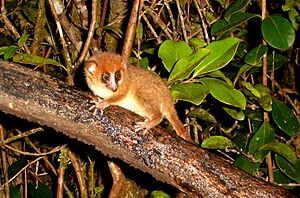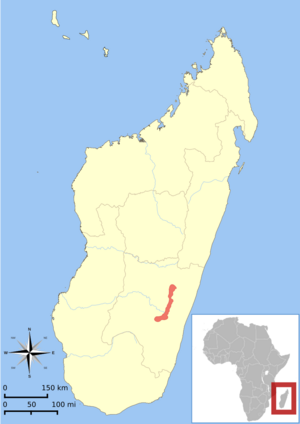Brown mouse lemur facts for kids
Quick facts for kids Brown mouse lemur |
|
|---|---|
 |
|
| Conservation status | |
| Scientific classification | |
 |
|
| Distribution of M. rufus | |
| Synonyms | |
|
The brown mouse lemur (Microcebus rufus) is a very small primate. Like other mouse lemurs, it lives only on the island of Madagascar. People also call it the rufous mouse lemur or red mouse lemur. Its back is brown or reddish-brown. Its belly is a whitish-grey color.
Mouse lemurs are among the primates that live the shortest lives. Brown mouse lemurs usually live for 6 to 8 years in the wild. However, they can live up to 12 years when cared for by humans.
You can find these lemurs in the rainforests of eastern Madagascar. They are shy and live alone. They are also nocturnal, meaning they are active at night.
Contents
How Scientists Name Them
Scientists give every animal a special name. This helps everyone know exactly which animal they are talking about. The brown mouse lemur's scientific name is Microcebus rufus.
A scientist named Étienne Geoffroy Saint-Hilaire first described this type of lemur in 1836. But he did not give it a full scientific name. Later, René Lesson gave it the name Microcebus rufus. Today, many scientists agree that Lesson is the one who officially named the species.
For a long time, the brown mouse lemur was thought to be a type of gray mouse lemur. But in 1977, scientists realized it was its own unique species.
What Do Brown Mouse Lemurs Eat?
Brown mouse lemurs are nocturnal creatures. This means they sleep during the day. They wake up at night to search for food.
They eat many different things. Their diet includes insects, fruits, and flowers. They also eat other parts of plants. They love fruit the most, so scientists call them "frugivorous." But they can also eat other things, making them "omnivores."
These clever lemurs can store fat in their bodies. They can store up to 35% of their body weight as fat. This fat is kept in their back legs and tail. It acts like a stored energy supply. They use this energy when food is hard to find.
Life and Family
Brown mouse lemurs become adults when they are about one year old. This is when they can start having babies.
They have a special way of finding a mate. A male lemur will make soft squeaking sounds. He might also lash his tail to get a female's attention. After mating, the female will make a warning sound. Some male lemurs that are stronger or more dominant might have several mates.
Brown mouse lemurs usually mate between September and October. Their babies are often born in November or December. A female can have one to three babies at a time. She might have one or two litters of babies each year. When winter comes, the young male lemurs leave the area where they were born.
Where Do They Live?
Brown mouse lemurs usually make their homes in tree holes. They also build nests using leaves. Sometimes, they even use old bird nests.
They often gather in groups to make these nests. These groups are usually made up of young lemurs and female lemurs.
What Threats Do They Face?
The biggest danger to brown mouse lemurs is the loss of their home. People cut down forests to clear land for farming. This is called "slash-and-burn" agriculture. When the forests are gone, the lemurs have nowhere to live.
They also face dangers from natural predators. Some animals that hunt brown mouse lemurs include:
- The fossa (Cryptoprocta ferox)
- The ring-tailed mongoose (Galidia elegans)
- Owls (Strigiformes)
- The Madagascar harrier hawk (Polyboroides radiatus)
Brown mouse lemurs help the forest by spreading seeds. When they eat fruits, they carry the seeds to new places. This helps new plants grow. Because of deforestation, these lemurs are at risk of disappearing forever. This is why they are listed as a vulnerable species.
See also
- Lemurpediculus verruculosus



